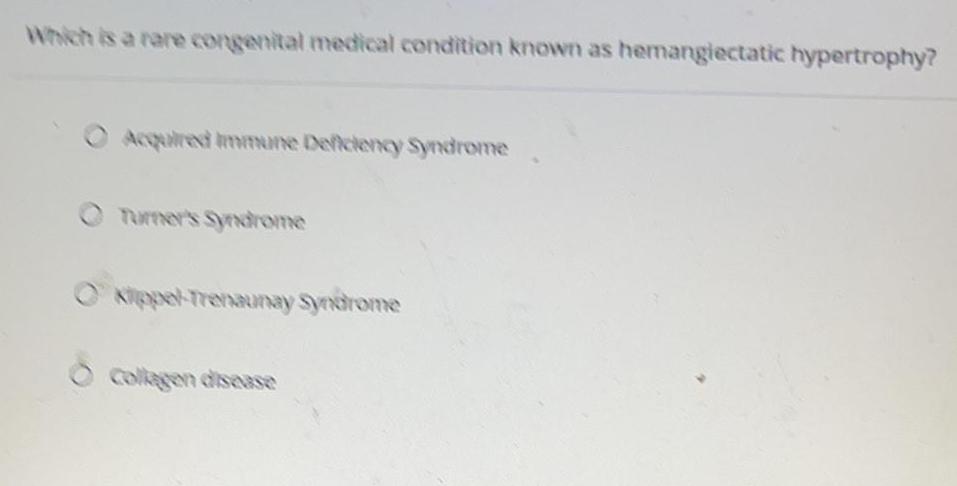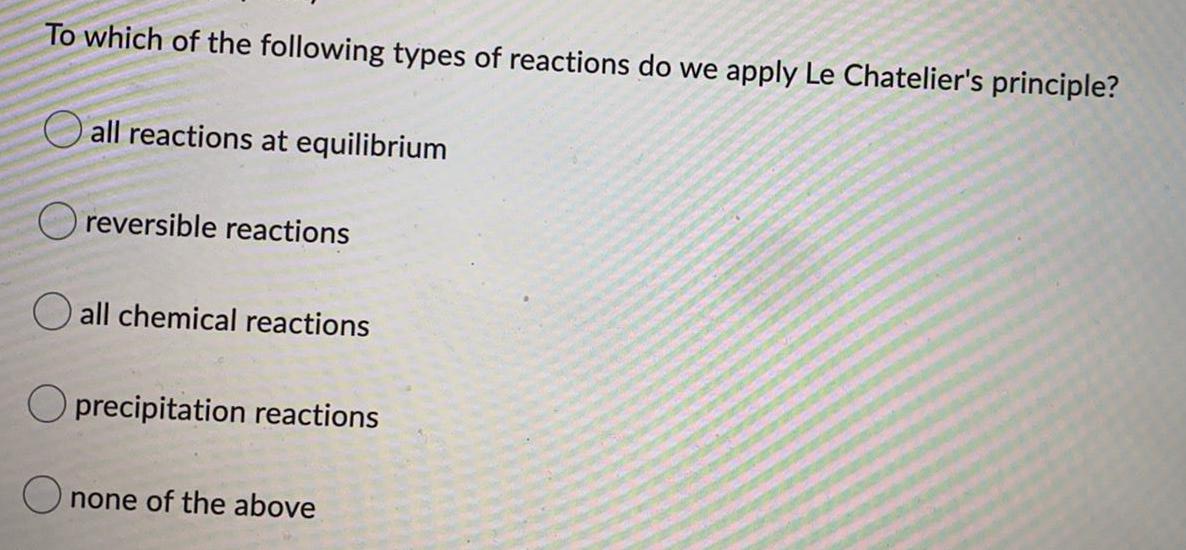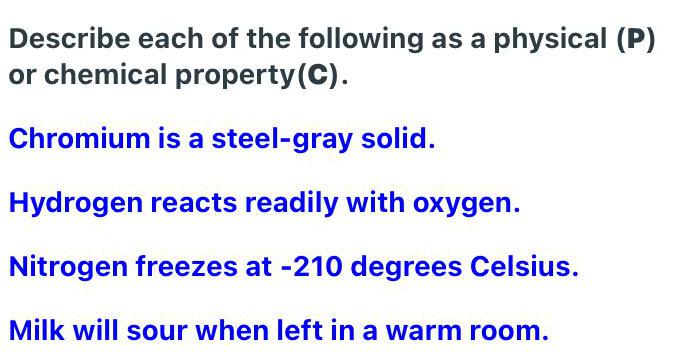Qualitative analysis Questions and Answers

Inorganic Chemistry
Qualitative analysisGas density can be calculated by dividing the mass of gas by its volume. If you took a balloon of gas and then warmed the balloon in a sunny window, what can now be said about the density of the gas in the balloon?
The gas density will increase.
The gas density will remain the same.
The density of gases is independent of temperature.
The gas density will decrease.

Inorganic Chemistry
Qualitative analysisWhich is a rare congenital medical condition known as hemangiectatic hypertrophy?
Acquired Immune Deficiency Syndrome
Turner's Syndrome
Okippel-Trenaunay Syndrome
Collagen disease

Inorganic Chemistry
Qualitative analysisGiven the following information, what is the ΔHºf (heat of formation for ZnS(s)?
Thermochemical equation: 2ZnS(s) + 302(g) → 2ZnO(s) + 2SO2(g)
ΔH°f of ZnO(s) = -348.3 kJ/mole
ΔH°f of SO2(g) = -296.8 kJ/mole
The heat of formation is
ΔH°rxn = -878.2 kJ

Inorganic Chemistry
Qualitative analysisWhat is the change in enthalpy in joules when 5.44 x 10^-4 mol of AgCl dissolves in water according to the following chemical equation:
AgCl(s)→ Ag (aq) + CI (aq) ΔH = 65.5 kJ

Inorganic Chemistry
Qualitative analysisWhat is the mass of one uranium pellet?
7 grams
70 grams
500 grams
50 grams

Inorganic Chemistry
Qualitative analysisA 11.5 mL aliquot of 0.157 M H3PO4 (aq) is to be titrated with 0.246 M NaOH(aq). What volume (mL) of base will it take to reach the equivalence point?
2.45
22.0
99.3
1.33
7.34

Inorganic Chemistry
Qualitative analysisPhotosynthesis uses 660-nm light to convert CO₂ and H₂O into glucose and O2. Calculate the frequency of this light.
Frequency= Hz

Inorganic Chemistry
Qualitative analysisDespite his reputation as an idiot, Emperor Justinian is also regarded well for
A. The Taj Mahal
B. The Pyramids
C. The Hagia Sophia
D. The Sphynx

Inorganic Chemistry
Qualitative analysisThe culture in the pre-Islamic Arabian peninsula (present day Saudi Arabia)
was
A. Nomadic
B. Tribal
C. Undefined
D. Stationary

Inorganic Chemistry
Qualitative analysis1. Which organism is made up of one prokaryotic cell?
(25 Points)
A. bacteria
B. flower
C. bear
D. cactus
![A pump for a small swimming pool will circulate 2.87 x 102 gallons/hour through the filter. If the pool contains 4.15 x 105 ounces of water, how many seconds will it take
to filter the entire contents of the pool?
Known: 4.00 quarts = 1.00 gallons and 1.00 quart = 32.0 ounces
The entire pool will be filter in [a] s.
(give your answer in the scientific notation Y.YY x 10^XX)](https://media.kunduz.com/media/sug-question/raw/52503011-1659253038.9972758.jpeg?w=256)
Inorganic Chemistry
Qualitative analysisA pump for a small swimming pool will circulate 2.87 x 102 gallons/hour through the filter. If the pool contains 4.15 x 105 ounces of water, how many seconds will it take
to filter the entire contents of the pool?
Known: 4.00 quarts = 1.00 gallons and 1.00 quart = 32.0 ounces
The entire pool will be filter in [a] s.
(give your answer in the scientific notation Y.YY x 10^XX)
![It is important to know the difference between a piece of evidence and an explanation. 9 Which passage is the explanation of the following evidence (data)? Saki begins the story about two feuding neighbors noting that "the game for whose presence [Ulrich] kept so keen an outlook was none that figured in the sportsman's calendar" and that Ulrich von Gradwitz "patrolled the dark forest in quest of a human enemy" (Saki 1).
A. Passage #1
B. Passage #2
C. Passage #3
D. Passage #4](https://media.kunduz.com/media/sug-question/raw/52506027-1659252965.654383.jpeg?w=256)
Inorganic Chemistry
Qualitative analysisIt is important to know the difference between a piece of evidence and an explanation. 9 Which passage is the explanation of the following evidence (data)? Saki begins the story about two feuding neighbors noting that "the game for whose presence [Ulrich] kept so keen an outlook was none that figured in the sportsman's calendar" and that Ulrich von Gradwitz "patrolled the dark forest in quest of a human enemy" (Saki 1).
A. Passage #1
B. Passage #2
C. Passage #3
D. Passage #4

Inorganic Chemistry
Qualitative analysisA fictional element has two isotopes, each making up 50% of the population. Isotope 1 has a mass of 80.0 amu, Isotope 2 has a mass of 85.0 amu. Calculate the atomic mass of the fictional element.
82.5 amu
40 amu
165 amu
42.5 amu

Inorganic Chemistry
Qualitative analysisThe energy of a particular color of green light is 3.87×10^-22 kJ/photon.
The wavelength of this light is


Inorganic Chemistry
Qualitative analysisDraw the Lewis structure for SF5CI in the window below and then answer the questions that follow.

Inorganic Chemistry
Qualitative analysisWrite electron configurations for the most stable ion formed by each of the elements Al, Sr, O, and F
Electron configuration for the most stable ion of Al =
Electron configuration for the most stable ion of Sr =
Electron configuration for the most stable ion of 0 =
Electron configuration for the most stable ion of F =

Inorganic Chemistry
Qualitative analysisUse the octet rule to predict the formula of the compound that would form between arsenic and hydrogen, if the molecule contains only
one arsenic atom and only single bonds are formed.

Inorganic Chemistry
Qualitative analysisPredict the type of bond (ionic, covalent, or polar covalent) one would expect to form between the following pairs of elements.
a. C and Cl
b. Cs and Br
c. Na and Cl
d. F and F
e. Li and Cl
f. K and F

Inorganic Chemistry
Qualitative analysisCompare the magnitude of the lattice energy for each of the following two ion pairs.
(a) Cs+ and Br- separated by a distance of 393 pm
(b) Cs+ and I- separated by a distance of 423 pm

Inorganic Chemistry
Qualitative analysisFrom 600 C.E. to 1450 C.E, trade networks increased the level of affluence in many societies, which had an adverse effect on
A. children
B. education
C. the economy
D. women

Inorganic Chemistry
Qualitative analysisWhich of the following statements is true, according to the collision theory?
all collisions result in reactions
entities must collide to react
entities that collide but are incorrectly oriented will form a different product
all entities in a collision have the same quantity of kinetic energy
none of the above

Inorganic Chemistry
Qualitative analysisSilver bromide was prepared by reacting 200.0 grams of magnesium bromide and an
adequate amount of silver nitrate. Calculate the percent yield if 375.0 grams of silver
bromide was obtained from the reaction.

Inorganic Chemistry
Qualitative analysis3. Find the molar mass of (a) nitric acid, HNO3; (b) nickel (II) nitrate, Ni(NO3)2; and (c)
potassium hydrogen carbonate, KHCO3
(a)
(b)
(c)

Inorganic Chemistry
Qualitative analysisAbsent any form of central authority after the fall of Rome, people in Western Europe were paying up to three quarters of their income for ______.
A. food
B. taxes
C. medical attention
D. protection

Inorganic Chemistry
Qualitative analysisTo which of the following types of reactions do we apply Le Chatelier's principle?
all reactions at equilibrium
reversible reactions
all chemical reactions
precipitation reactions
none of the above

Inorganic Chemistry
Qualitative analysisFe³+ (aq) + SCN¹-(aq) <======> FeSCN¹-(aq)
(colourless) (brown) (deep red)
What is observed if a few drops of iron (III) chloride is added to this equilibrium?
nothing happens
it becomes darker red
none of the above
it becomes lighter red
becomes colourless

Inorganic Chemistry
Qualitative analysisA chemist must dilute 45.7 mL of 909. mM aqueous iron(II) bromide (FeBr₂) solution until the concentration falls to 203. mM. She'll do this by adding distilled water to the solution until it reaches a certain final volume.
Calculate this final volume, in liters. Be sure your answer has the correct number of significant digits.

Inorganic Chemistry
Qualitative analysisIn a coffee-cup calorimeter, 1.56 g NH4NO3 is mixed with 75.0 g water at an initial temperature of 25.22°C. After dissolution of the salt, the final temperature of the calorimeter contents is 23.36°C. Assuming the solution has a heat capacity of 4.18 J/°C-g and assuming no heat loss to the calorimeter, calculate the enthalpy change for the dissolution of NH4NO3 in units of kJ/mol.

Inorganic Chemistry
Qualitative analysisA chemist adds 415.0 mL of a 8.15 x 10-5 mol/L zinc oxalate (ZnC₂O4) solution to a reaction flask. Calculate the micromoles of zinc oxalate the chemist has added to the flask. Be sure your answer has the correct number of significant digits.

Inorganic Chemistry
Qualitative analysisDescribe each of the following as a physical (P)
or chemical property (C).
Chromium is a steel-gray solid.
Hydrogen reacts readily with oxygen.
Nitrogen freezes at -210 degrees Celsius.
Milk will sour when left in a warm room.

Inorganic Chemistry
Qualitative analysisFor the following reaction, 55.4 grams of potassium hydrogen sulfate are allowed to react with 21.5 grams of potassium hydroxide.
potassium hydrogen sulfate(aq) + potassium hydroxide(aq) → potassium sulfate(aq) + water(l)
What is the maximum amount of potassium sulfate that can be formed?
What is the FORMULA for the limiting reagent?
What amount of the excess reagent remains after the reaction is complete?

Inorganic Chemistry
Qualitative analysisWhen 170. J of heat are absorbed by 150. g of copper at 23.61 °C, the temperature increases to 26.51 °C. What is the specific heat of copper?

Inorganic Chemistry
Qualitative analysisAir bags are activated when a severe impact causes a steel ball to compress a spring and electrically ignite a detonator cap. This causes sodium azide (NaN3) to decompose explosively according to the following reaction:
2NaN3 (s) → 2 Na(s) + 3N₂(g)
What mass of NaN3 (s) must be reacted to inflate an air bag to 68.0 L at STP?

Inorganic Chemistry
Qualitative analysisHelium is collected over water at 25°C and 1.00 atm total pressure. What total volume of gas must be collected to obtain 0.487 g helium? (At 25°C the vapor pressure of water is 23.8 torr.)

Inorganic Chemistry
Qualitative analysisConsider separate 1.0-L samples of Kr(g) and UFG (g), both at 1.00 atm and containing the same number of moles. What ratio of temperatures for the two samples would produce the same root mean square velocity?

Inorganic Chemistry
Qualitative analysisIdentify each of the following as a physical (P) or chemical properties (C) of a candle: A candle is 10 in. high and 2 in. in diameter The wax of a candle softens on a hot day A candle burns The candle is blue

Inorganic Chemistry
Qualitative analysisAn aerosol can contains 380. mL of compressed gas at 4.80 atm. When all of the gas is sprayed into a large plastic bag, the bag inflates to a volume of 1.90 L. What is the pressure of gas in the plastic bag? Assume a constant temperature.

Inorganic Chemistry
Qualitative analysisConsider the following chemical equation:
2NO2(g) → N₂O4(g)
If 50.0 mL NO2 gas is completely converted into N₂O4 gas under the same conditions, what volume will the N₂O4 occupy?

Inorganic Chemistry
Qualitative analysisCombustion reactions involve reacting a substance with oxygen. When compounds containing carbon and hydrogen are combusted, carbon dioxide and water are the products. Using the enthalpies of combustion for C4H4 (-2341 kJ/mol), C4H8 (-2755 kJ/mol), and H₂ (-286 kJ/mol), calculate AH for the reaction.
C4H4 (g) + 2 H₂(g) → C4H4 (g)

Inorganic Chemistry
Qualitative analysisN₂O is a gas commonly used to help sedate patients in medicine and dentistry due to its mild anesthetic and analgesic properties; it is also nonflammable. If a cylinder of N₂O is at 10.1 atm and has a volume of 6.50 L at 298 K, how many moles of N₂O gas are present?
The gas from the cylinder is emptied into a large balloon at 755 torr.
What is the volume of the balloon at 298 K?

Inorganic Chemistry
Qualitative analysisThe energy content of food is typically determined using a bomb calorimeter. Consider the combustion of a 0.24-g sample of butter in a bomb calorimeter having a heat capacity of 2.67 kJ/°C. If the temperature of the calorimeter increases from 23.5°C to 26.0°C, calculate the energy of combustion per gram of butter.

Inorganic Chemistry
Qualitative analysisMethanol (CH3OH) has been proposed as an alternative fuel. Calculate the standard enthalpy of combustion per gram of liquid methanol.
Standard Heats of Formation:
CH3OH(l) = -239 kJ/mol
O2(g) = 0 kJ/mol
CO2(g)=–393.5 kJ/mol
H₂O(l) = -286 kJ/mol

Inorganic Chemistry
Qualitative analysis1. How many MOLECULES of boron tribromide are present in 3.50 moles of this compound?
2. How many MOLES of boron tribromide are present in 1.04×10^23 molecules of this compound?

Inorganic Chemistry
Qualitative analysisA mixture of nitrogen and krypton gases, in a 8.91 L flask at 52 °C, contains 5.43 grams of nitrogen and 20.4 grams of krypton. The partial pressure of krypton in the flask is ___ atm and the total pressure in the flask is ___atm.

Inorganic Chemistry
Qualitative analysisThe element magnesium forms a ____ with the charge ____
The symbol for this ion is ____ and the name is ____ ion.
The number of electrons in this ion is ___

Inorganic Chemistry
Qualitative analysisYou have a certain mass of helium gas (He) in a rigid steel container. You add the same mass of neon gas (Ne) to this container. Which of the following best describes what happens? Assume the temperature is constant.
The pressure in the container more than doubles.
The pressure in the container doubles.
The volume of the container more than doubles.
The volume of the container doubles.
The pressure in the container increases but does not double.

Inorganic Chemistry
Qualitative analysisOxygen gas can be prepared by heating potassium chlorate according to the following equation:
2KC1O3(s)- +2KCI(s) + 3O2(g)
The product gas, O₂, is collected over water at a temperature of 20 °C and a pressure of 745 mm Hg. If the wet O₂ gas formed occupies a volume of 8.57 L, the number of grams of O₂ formed is g. The vapor pressure of water is 17.5 mm Hg at 20 °C.

Inorganic Chemistry
Qualitative analysisA sample of hydrogen gas has a density of _____ g/L at a pressure of 1.08 atm and a temperature of 33 °C.

Inorganic Chemistry
Qualitative analysisA 9.200 mol sample of methane gas is maintained in a 0.8079 L container at 304.2 K. What is the pressure in atm calculated using the van der Waals' equation for CH4 gas under these conditions? For CH4, a= 2.253 L²atm/mol² and b= 4.278x10-² L/mol.